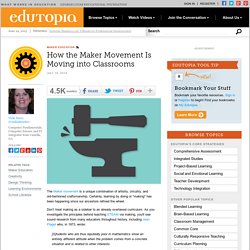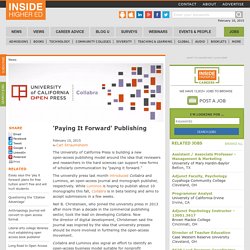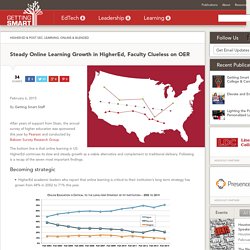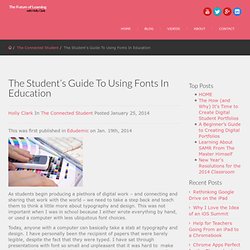

12 Tech Fads in Higher Ed. What's Hot and What's Not in Ed Tech for 2015. 4 Innovative New Tools to Try Next Year. How the Maker Movement Is Moving into Classrooms. The Maker movement is a unique combination of artistry, circuitry, and old-fashioned craftsmanship.

Certainly, learning by doing or "making" has been happening since our ancestors refined the wheel. Don’t treat making as a sidebar to an already overtaxed curriculum. As you investigate the principles behind teaching STEAM via making, you'll see sound research from many educators throughout history, including Jean Piaget who, in 1973, wrote: [S]tudents who are thus reputedly poor in mathematics show an entirely different attitude when the problem comes from a concrete situation and is related to other interests. In 1972, Seymour Papert predicted what many complain is the state of today's apps and programs for modern students: [T]he same old teaching becomes incredibly more expensive and biased toward its dumbest parts, namely the kind of rote learning in which measurable results can be obtained by treating the children like pigeons in a Skinner box.
Maker classrooms are active classrooms. U. of California Press builds open-access publishing model around 'paying it forward' The University of California Press is building a new open-access publishing model around the idea that reviewers and researchers in the hard sciences can support new forms of scholarly communication by "paying it forward.

" The university press last month introduced Collabra and Luminos, an open-access journal and monograph publisher, respectively. While Luminos is hoping to publish about 10 monographs this fall, Collabra is in beta testing and aims to accept submissions in a few weeks. Neil B. Christensen, who joined the university press in 2013 after more than a decade in the commercial publishing sector, took the lead on developing Collabra. Now the director of digital development, Christensen said the journal was inspired by the idea that university presses should be more involved in furthering the open-access movement. Collabra and Luminos also signal an effort to identify an open-access business model suitable for nonprofit institutions such as colleges and universities. Steady Online Learning Growth in HigherEd, Faculty Clueless on OER. After years of support from Sloan, the annual survey of higher education was sponsored this year by Pearson and conducted by Babson Survey Research Group.

The bottom line is that online learning in US HigherEd continues its slow and steady growth as a viable alternative and complement to traditional delivery. Following is a recap of the seven most important findings. Becoming strategic HigherEd academic leaders who report that online learning is critical to their institution’s long term strategy has grown from 48% in 2002 to 71% this year. Efficacy? About three quarters of academic leaders rate the quality on online learning superior to those in face-to-face instruction.However, only 28% of academic leaders say that their faculty members accept the “value and legitimacy of online education,” unchanged from 2003. Growth Growth of online learning slowed to 4% but it’s still growing faster than face-to-face.
The Future of Learning The Student’s Guide To Using Fonts In Education. This was first published in Edudemic on Jan. 19th, 2014 As students begin producing a plethora of digital work – and connecting and sharing that work with the world – we need to take a step back and teach them to think a little more about typography and design.

This was not important when I was in school because I either wrote everything by hand, or used a computer with less ubiquitous font choices. Today, anyone with a computer can basically take a stab at typography and design. I have personally been the recipient of papers that were barely legible, despite the fact that they were typed. I have sat through presentations with font so small and unpleasant that it was hard to make out what is being said. Know Your Fonts What is the difference between Serif and Sans Serif?
There are two types of font – serif and san serif. Compile Some Favorites We should work from a repertoire of about 10 fonts and use those consistently – and learn to make critical thinking decisions about font choice. 2015-horizon-he-preview.pdf.